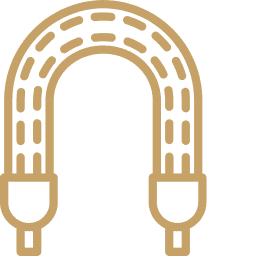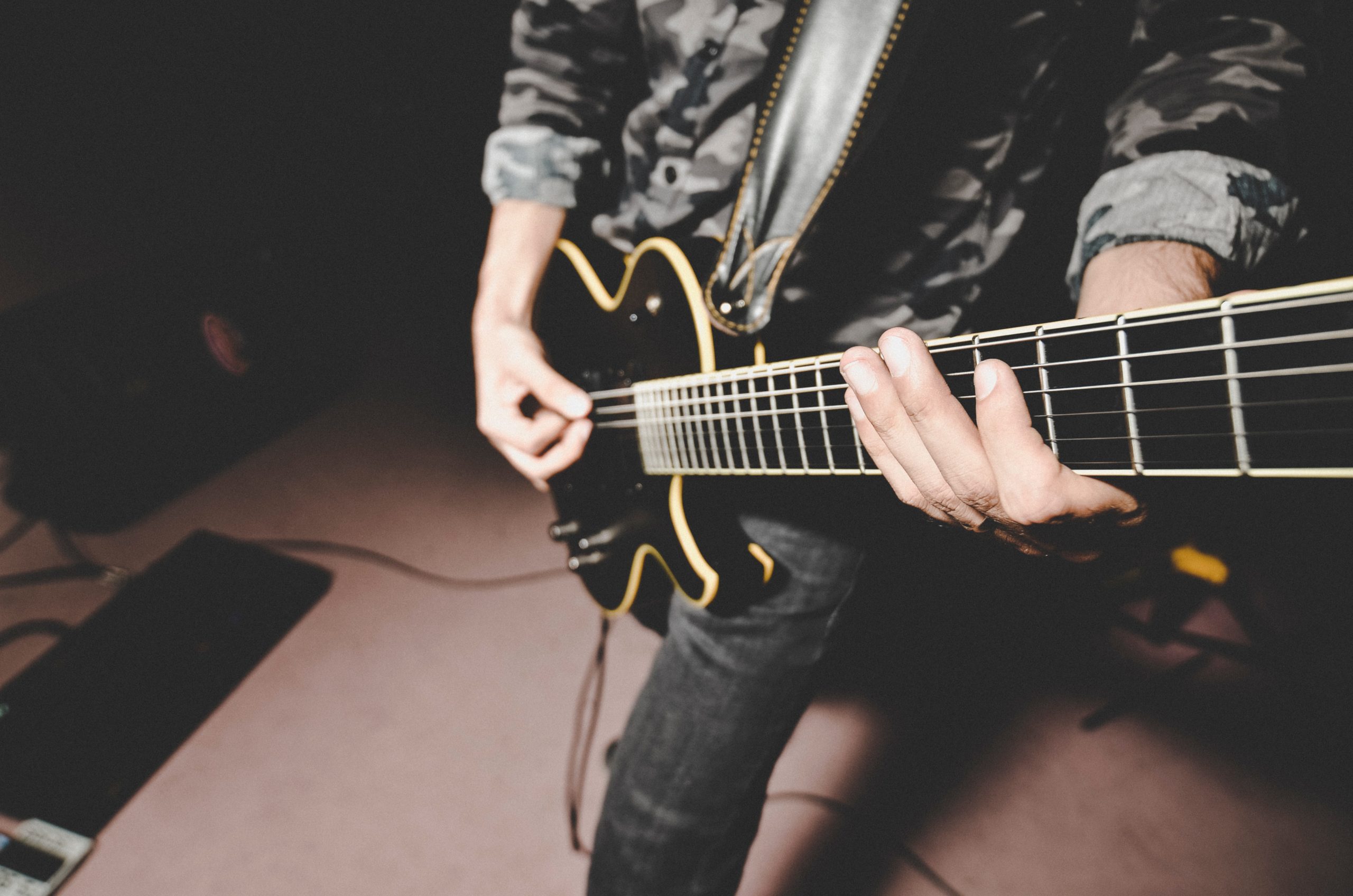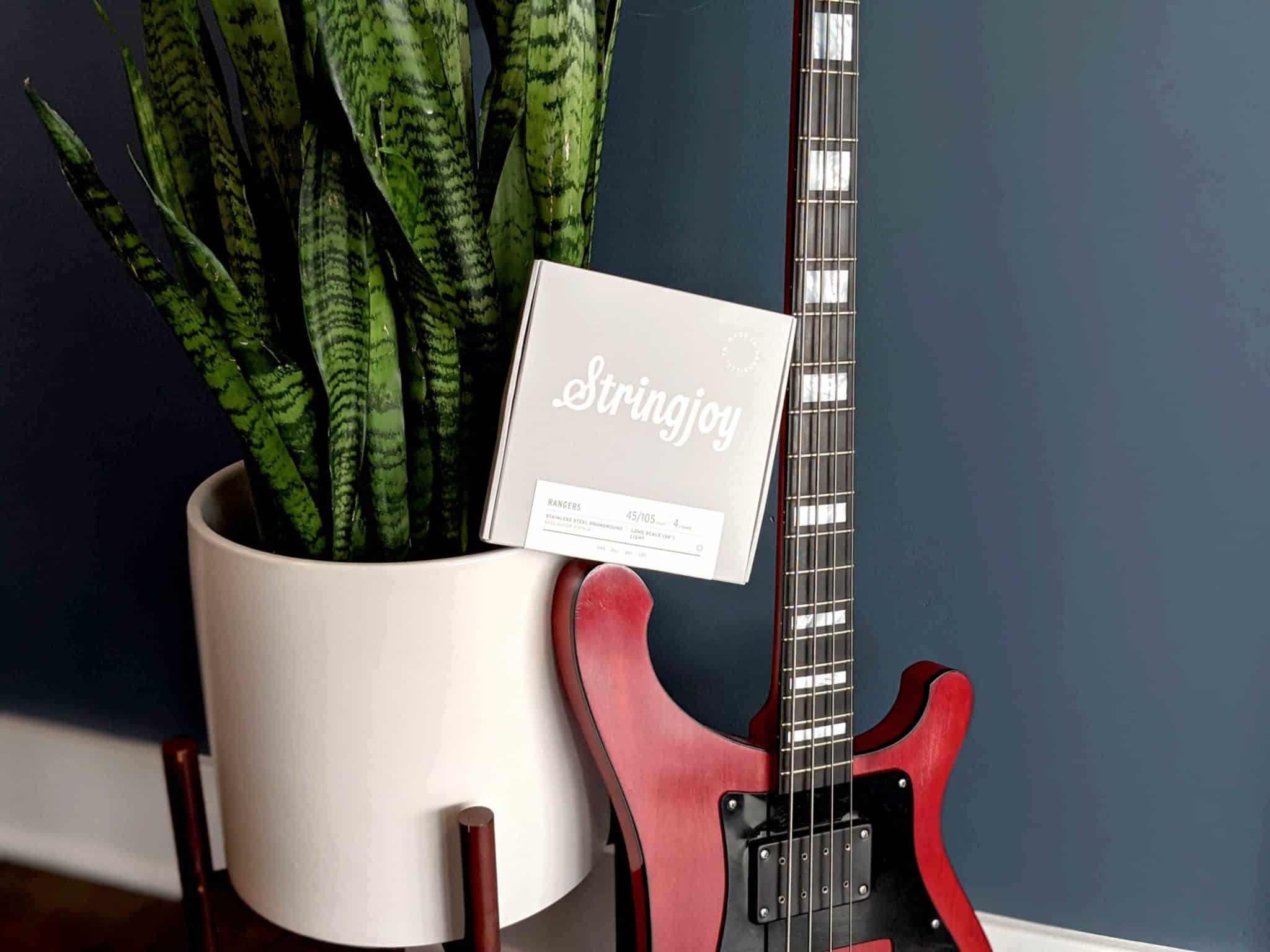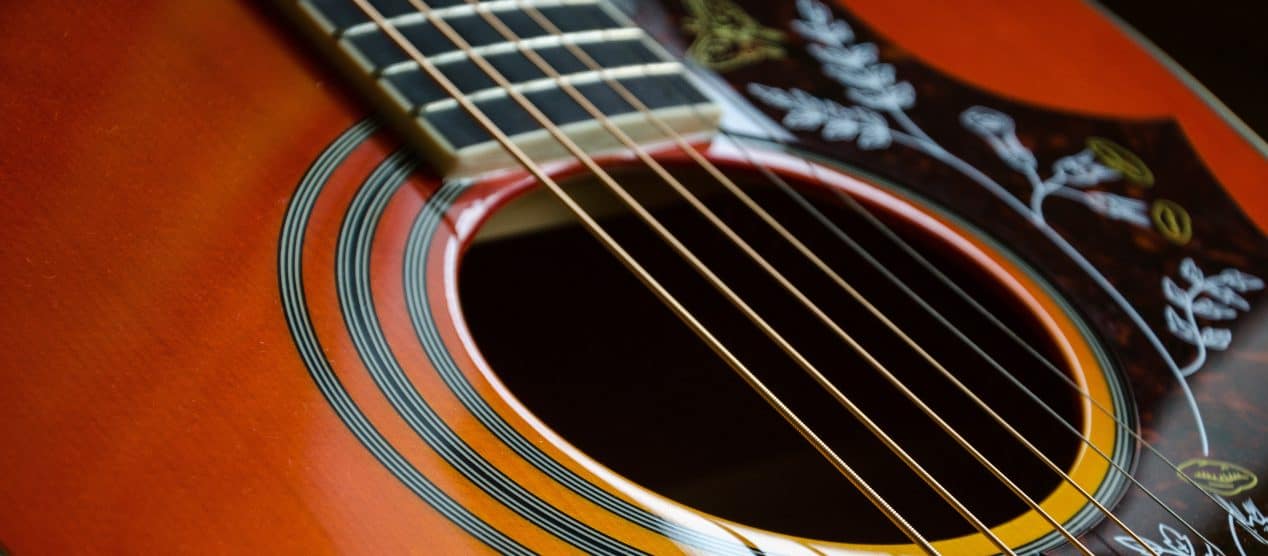Super Light Electric Guitar Strings – or 9s – sometime get a bad rap, but do they deserve it? We don’t think so…
Be sure to subscribe to our YouTube channel to keep up with more great videos like this one:
Want to try a set of Super Light Electric Guitar Strings?
We’ve got a few great gauge options so you can pick the perfect set for you. Check them out HERE.
Transcription
Hey, I’m Scott from Stringjoy Guitar Strings and today we’re talking about 9s—or super light guitar strings for the electric guitar. Super light strings get a pretty bad rap a lot of the time. I think a lot of people think that if you play 9s it’s either because you’re just a beginner or you’re too weak to bend or something crazy like that.
You see a lot of this criticism flying around especially on the Internet. The example that I think of the most often is there’s a meme that’s going around of a prince putting on lipstick and saying “I only play 9s,” as though it’s kind of like a delicate thing or something like that. Frankly, I think that’s a little bit unfair.
Today we’re going to talk about 9s. We’re going to talk about what they’re good for, what they’re not as good for, who has used them and also why some sets of 9s are better than other sets of 9s. So we’ll see whether they could be something that you should look at to integrate into your rig even if you haven’t played Super Light electric guitar strings in a long time or if you’re somebody who plays 9s currently, we’ll talk about what you can say to people that might give you flack in the future.
Super Light Guitar Strings History
Before we jump into what’s good about 9s or what’s bad about 9s, I wanted to talk really quickly about where 9s actually came from—which might kind of seem like a strange question but it’s not exactly what you might think.
Back in the 40s and the 50s, it was really, really hard to get light gauge electric guitar strings. They didn’t even really make them. They just had 12s and 13s. Basically, the same sort of sets that you would see for an acoustic guitar, just made out of nickel for electric guitars.
Eventually, once players wanted to get lighter gauge strings that they could bend a lot further, they started trying to invent these sets out of those available sets that were a lot like acoustic sets. So what they would do was take a set of 12s or a set of 11s if they could find them, they would find a really light gauge string like a 9 typically from like a banjo set or something like that, they would sub it on top of that existing set of strings and then they would just scoot everything down one.
So the 42 that would have been like the fifth gauge string would be the sixth for this set, and then everything would kind of slide on down. So that’s where 9s actually came from. You get a 9, pop it on top, slide everything else from a 12 on down, which is also why people started using plain thirds, because the plain second string became a plain third string and basically everything has just kind of come from that.
Famous players that have used Super Light Electric Guitar Strings
Believe it or not, throughout history a lot of really, really famous or big-time guitarists have used super light electric guitar strings pretty regularly. I’m talking about everyone from Eddie Van Halen to Frank Zappa to Randy Rhoads, Angus Young, Mark Knopfler, on and on and on the list goes. Before we even jump in, if you think that 9s are only for beginners or that pro guitarists never use 9s, just completely discard that view because it’s just not really true.
Advantages of Super Light Electric Guitar Strings
What are the big advantages of using 9s? The first one you could probably guess, which is that you can bend a lot further on a set of 9s than you could on a set of 10s or a set of 11s.
Sure, if you’re Stevie Ray Vaughan you could probably bend two whole steps on a set of 13s, but for most of us humans, that’s not really very possible. So with a set of 9s you can get a lot bigger of bends than you probably could otherwise, like those Led Zeppelin-style two whole step bends. (Side note, Jimmy Page would actually 8s a lot of times so that he could really, really, really get those bends, but 9s will get you a lot of the way there.)
The thing about 9s, though, is it’s not just that you can bend way further on the high strings—the plain steel strings—when you’re soloing, because you have lighter gauges throughout the entire set. So you can get a lot more vibrato with your wound strings too, which can add a lot more expression to your riffs.
The second big advantage of Super Light electric guitar strings is if you’re playing a style of music where you like a lot of fret action, then lighter gauge strings will give you a lot more of that. What I’m talking about here is the actual sound of the strings interacting with the frets on your guitar. Slap bass is basically the style of sound that I’m talking about.
So if you’re playing a lot of funk guitar, lighter gauge strings can work really well for you. To a certain extent country could work, but typically guys in country are using a little bit of heavier gauge strings, still it could be something interesting to try as well.
Disadvantages of Super Light strings
Now, unfortunately, there are also some disadvantages of using a really light gauge set of strings that are kind of unavoidable.
The first one that you’re going to probably be familiar with is that you might break more strings. Now, it’s not to say that if you play 9s you’re gonna be breaking strings left and right. If you have your guitar properly set up, you don’t have any sharp edges on the bridge or the tuning peg, you’re wiping down your strings when you’re done playing, keeping your guitar in a case, all that sort of basic stuff, you shouldn’t be breaking strings at any sort of really quick clip. But, you are more likely to break strings when they’re thinner than you are when you’re using thicker, tougher strings.
(Honestly, if you think about it, it’s almost amazing that a set of Super Light electric guitar strings can hold out as long as it can. If you think of the diameter on a set of 9s, it’s really, really thin. I mean, it is almost like an angel hair string and it’s being stretched across sharp edges, hit with a plectrum, in different weather conditions, getting sweat and dirt and all that stuff on it. When you think about it, the fact that some 9s will last you months and months and months or even a year or more, that’s pretty insane. So, in some ways, we have to give these strings good credit because with them being that small, it’s amazing they’re able to last as long as they sometimes are.)
I think the other disadvantage of really light strings actually comes in your clean tone. So if you’re playing with a really dirty or distorted tone, I think the thickness of your strings comes out a little bit less in your playing than otherwise.
A good example is Jimmy Page with Led Zeppelin. When you’re playing through a whole wall of Marshall full stacks, having a slightly lighter gauge set of strings isn’t going to make a fifty percent difference in your tone. The sound is in your fingers and your guitar and that massive wall of Marshall full stacks. But, when you’re playing with a much more stripped down or barer tone, I think you can definitely hear the strings a lot more.
So this is the reason that in genres like jazz you see guys playing much heavier sets of strings. There’s a lot of different reasons for that, but one of the chief ones is that you get a very full, resonate, big sound even when it’s just your guitar plugged in with an amp, maybe with a little bit of reverb.
So, if you’re playing clean a lot, and you really want that big, bell-like tone, I might suggest looking at some slightly heavier gauge sets of strings, 10s or 11s or, heck, even 12s if you can muster it, will do really well there.
But, if you’re not really playing clean very often and you’re really playing dirty or with a lot of distortion, I think 9s or lighter are gonna work just fine for you without really making a huge difference in the overall tone of your guitar, certainly not one that you can’t correct with a little bit of EQ’ing on the amp.
Should you play 9s?
So, are 9s right for you? Well, I can’t really be the one to say, but I will say this. If you haven’t considered Super Light electric guitar strings in a long time—maybe you played them years and years and years ago and haven’t looked back, I would say that you should check them out again.
So, for me, I got this little Epiphone Hollow Body in a trade in Nashville a couple months ago. When I got it the guy had a set of 9s on there, and I didn’t really feel like changing the strings on it just when I got it. So I took it home, plugged it in my rig and, you know, dialed in everything a little bit more. I had to turn up the bass on the EQ side and all that to make it all work just right. But once I did, I was really, really impressed.
See, I’m not a huge solo-er, so I didn’t really think it mattered very much about getting those extra bends for my style. But, on the bottom end, on the wound strings, I was really amazed by how big of a difference it made for my riffs because I could do a lot more in terms of vibrato on the bottom end than I had ever been used to in a long time.
Now I’m playing a set of 9.5s, like 9.5 to 44 or 46 on the very bottom there, to kind of be right in the middle, but I had never really considered playing something under a set of 10s. It’d been a long time since I’d done that and when I did it made a really big difference for me. So I would recommend checking them out and seeing if it might be something that could bring about some new rifts or some new ideas for you.
What sets one set of 9s apart from another?
Before you run out and buy a set of Super Light electric guitar strings, there is one major difference between different sets of 9s and I don’t just mean in terms of who’s making them or what material you’re using but the gauges can be really different between them as well. Before you do, listen to this…
A typical set of 9s that you’ll see form a lot of brands goes 9, 11, 16, 24 wound, 32 and 42. Like we talked about earlier, that is in many ways just a holdover set from back when there used to be wound third, heavy gauge electric guitar string sets and people would start throwing a 9 on top and then just assemble the rest of the set out of what was left over. But it isn’t necessarily perfect.
The one big, big difference between a lot of different sets of strings is that some go 9, 12, 15 on the very top—that’s how ours go. Some others will go 9, 11, 16. In my opinion, 9, 12, 15 is vastly better than 9, 11, 16. There are two different reasons for this.
One is that sort of chronically in electric guitar string sets, there’s a much lighter gauge B-string than there ought to be. Sometimes it’s subtle and sometimes it’s a lot. On a set of 10s, it’s a 13 that you typically see. We use a 13.5 and on a set of 9s it’s an 11 when I think it really should be a 12.
The other even bigger difference is on the G string. 15 balances really, really well with a 9 and a 12. It has almost the same amount of tension as the 9 and the 12. I think literally less than .2 pounds difference. A 16, on the other hand, has a lot more tension than an 11 and even more than a 9.
The problem there is that the G string on an electric guitar really tends to stand out. If you strum a chord, a lot of times you can really, really hear the G if you’re playing a not perfectly balanced set. So the 16 being a lot heavier amplifies that even more and you really get the sound of your G above everything else in the cord, and I think it ends up kind of making everything sound a little bit unnatural and a little bit unbalanced.
So, if you see a set that goes 9, 12, 15, 24, 32, 42, like ours does at Stringjoy, I would absolutely recommend sticking with that set. It’ll have much more full balanced, even tonality than one of the 9, 11, 16 sets.
So what do you think? Are you one of the people that plays Super Light electric guitar strings and loves them? Are you one of the folks that says they wouldn’t touch a set of 9s with a ten-foot pole? Are you like me and play different gauge strings on different guitars for different effects? Let us know in the comments. Talk about what gauge of string you play and why you love it. If you like this video, I hope you’ll give it a like and subscribe so you can keep up with more great stuff from us in the future.










11 Responses
I am a strat man over 50 years BUT I have recently put size 9 strings on a few acoustics that I have so that I can bend like an electric guitar and I am very happy with the action (no buzz and set up like an electric one ) I am delighted with the sound (fender bullets) and playability of them never break any of them altho when not playing finger style I use Dunlop 43/48 size plectrums I find if I bend the centre of the pick when playing it is as rigid as a heavy duty one so there you are horses for courses and I have gone through over 200 guitars in my lifetime Bop till you drop cheers
I am trying to custom gauge a set for my 4 string electric mando. Given the tuning is at a much higher pitch, are 7s, 8s, or 9s likely to break more often than 10s? Is there any significant difference in material composition between brands?
Thanks
Gary
I went down to 8’s years ago, and now use 7’s Billy Gibbons but the High E usually breaks so I just replace it with an Earnie Ball .08. Had to because of wrist pain from 30 years of playing. you must have a quality well built guitar to accommodate a super duper light gauge string. If there were 6’s out there I would try those as well.
I’ve had carpal operations and suffer from arthritis. I’m going to give your lighter strings a go. Cheers Ian
Hope they treat you great Ian!
I moved to 9’s due to arthritis problems after many years, this whimpy B (11) and extra loud G (16) is an irritation to say the least. I cannot wait to try some of your strings, most companies just stick with what they have been making for years – whether that actually works for us players or not! Overall, they are not nearly as lousy a sound as I expected, 9’s took an adjustment but I don’t miss aching hands.
I have a couple of guitars I run 9’s on & I MUCH prefer a 15 for a G/3rd string!
I have been using 9’s for 20 years…..anything heavier,just doesn’t feel comfortable to me….I like what I like….I just bought a set of your balanced 9 sets…..they haven’t arrived yet,but I can’t wait to try them…I recently bought a guitar that had been setup with 10’s,and I almost sent the guitar back it was so uncomfortable to play…..so yeah,I love my 9’s…..I am a little curious about the 9 1/2 gauges though…..I may give those a try if I like these….
Hey Scott !!! Yeah when I started playing back in 1972, the only strings I could get were Black Diamonds that might as well have been bailing wire. A little 12 year old was no match for the 12’s or 13’s that the Drug store sold 14 miles away from the farm. But they did force me to develop good rhythm skills.
I gave up on 9’s a couple years ago, but I have to try your balanced set. I never even heard of a 15 G string until I received this message. Thanks, Daniel Lang
Enjoyed the video on 9’s. One thing I like about Stringjoy is the option to order custom sets. I’ve starting stringing my Tele with a three saddle bridge with 9-13-16-26-36-46. Seems to be the best combination of bendability, tone and intonation for me. I play in a three piece band (low volume) so I have to do lead and a lot of chord work too. I may try something a little lignter on the bottom strings sometime. I have tried 9-12-15 on a Gibson and was surprised at how much I liked the 15. Enjoyed the discussion.
I use 8’s and change the G to a .15, tone is in the fingers.
Don’t forget those knobs on your amp will add the frequency’s you think you may be missing.